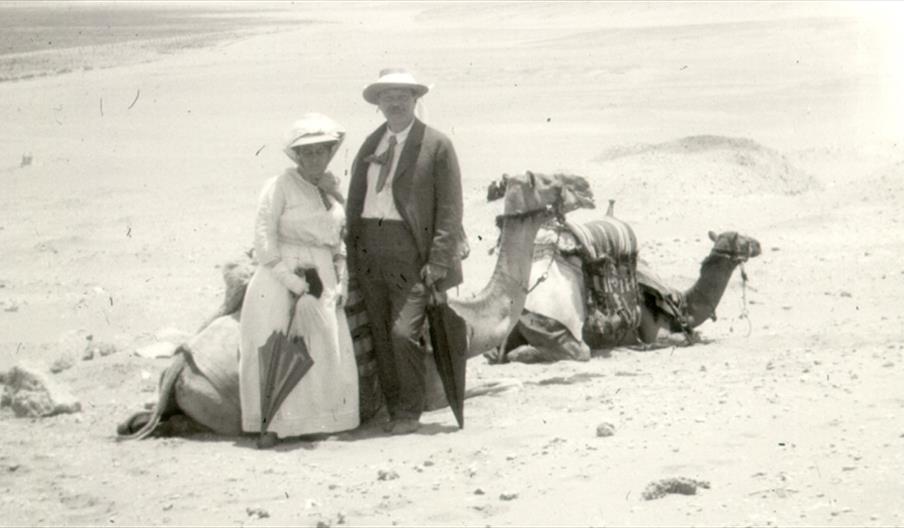Arthur Conan Doyle’s Mummies.
The Sherlock Holmes stories cast a long shadow over the life and career of Sir Arthur Conan Doyle. They often eclipse his other work, including his stories of the supernatural. Among these are The Ring of Thoth, and Lot No. 249. Both of these stories have an Egyptian theme, and both have proved to be highly influential.
The Ring of Thoth was first published in The Cornhill Magazine in January, 1890. It later appeared in a book of Arthur Conan Doyle’s stories, The Captain of the Pole-Star and Other Tales. The Ring of Thoth has since been published many times in collections of Conan Doyle’s stories and other anthologies.
Set in the Louvre in Paris, The Ring of Thoth has two main characters - the Egyptologist John Vansittart Smith, and an Egyptian named Sosra. In Ancient Egypt, Sosra discovers an elixir that can prolong life. However, his true love, Atma, dies of plague before he can give her the elixir. Sosra then embarks on a quest lasting many centuries for an antidote to the elixir. He eventually finds it in The Ring of Thoth in the Louvre. Sosra can die at last and rejoin his beloved Atma in the afterlife. As he tells John Vansittart Smith: “ I shall at last be able to shake off that accursed health which has been worse to me than the foulest disease. “
In 1892, Harper’s Monthly Magazine published Arthur Conan Doyle’s story, Lot No. 249. Set in the fictional Old College in Oxford, it tells the story of an Egyptian mummy that is bought at auction by a student named Edward Bellingham. Bellingham discovers how to reanimate and control the creature. He then sets it on to people against whom he has a grudge.
One of Arthur Conan Doyle’s early influences was the American master of the horror story, Edgar Allan Poe. This is evident in Conan Doyle’s description of the mummy: “ The blotched skin was drawn tightly from bone to bone, and a tangled wrap of black, coarse hair fell over the ears. Two thin teeth, like those of a rat, overlay the shrivelled lower lip. “
Another of the undergraduates is a medical student named Abercrombie Smith. He is pursued by the mummy along a ‘ lonely and little-frequented road ‘: “ Even as he gazed back at it, it had lessened its distance by twenty paces and was fast closing up on him. Out of the darkness he had a glimpse of a scraggy neck and of two eyes that will ever haunt him in his dreams. “
The denouement of Lot No. 249 comes when Abercrombie Smith confronts Edward Bellingham at gunpoint. Smith then forces Bellingham to destroy the mummy, together with some papyrus rolls that contain the secret of the re-animation.
Lot No. 249 has been published in a number of horror and supernatural anthologies. In 1967, it was also adapted for the British television series Sir Arthur Conan Doyle. The script was by the renowned television writer, John Hawkesworth.
Both The Ring of Thoth, and Lot No. 249 have inspired a number of cinema films. For example, the plot of the Universal Pictures film The Mummy, ( 1932 ), bears some resemblance to The Ring of Thoth. A ‘ Scroll of Thoth ‘ is even featured in the film.
Later came Hammer Film Productions The Mummy, ( 1959. ) This featured an early role for actor Christopher Lee as a murderous mummy who is controlled by an Egyptian named Mehemet Bey. This aspect of the plot is clearly inspired by Lot No. 249. The story was also adapted - albeit somewhat loosely - for the American horror anthology film Tales from the Darkside: The Movie, ( 1990. )
As a Detective with the Arthur Conan Doyle Collection, I enjoy researching the lesser-known aspects of Conan Doyle’s life and work. Finding out more about these stories has illustrated to me that he was not just ‘ the man who created Sherlock Holmes. ‘ He was a highly skilled writer in other fields too, whose influence is felt to this day.
END.

Related
Comments
Comments are disabled for this post.

 to add an item to your Itinerary basket.
to add an item to your Itinerary basket.





